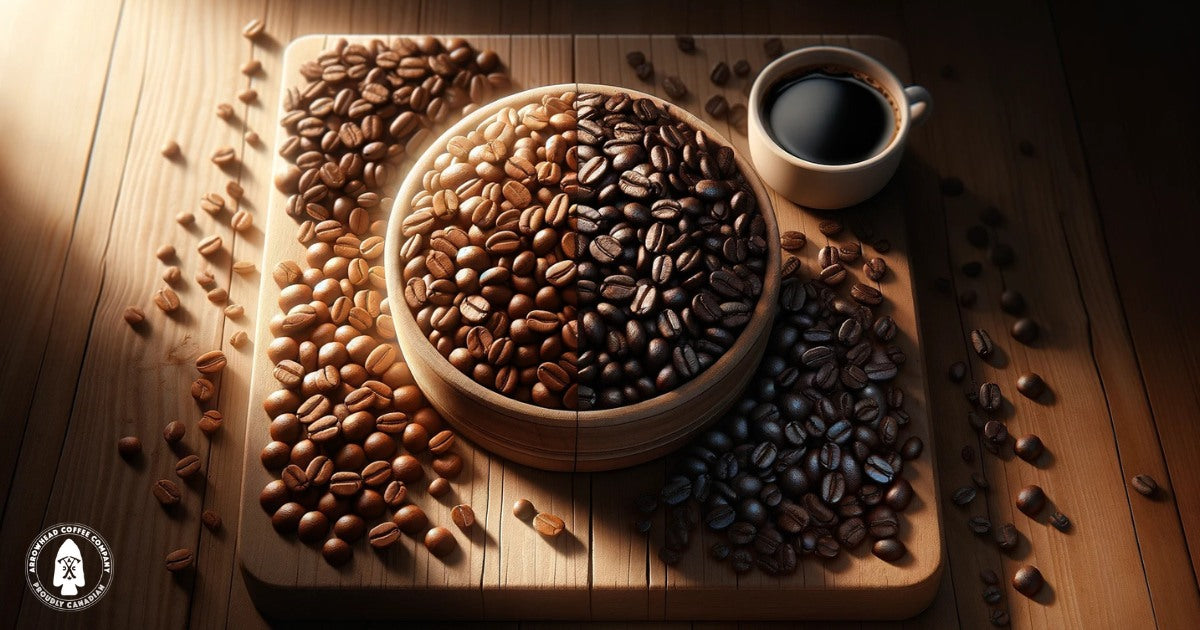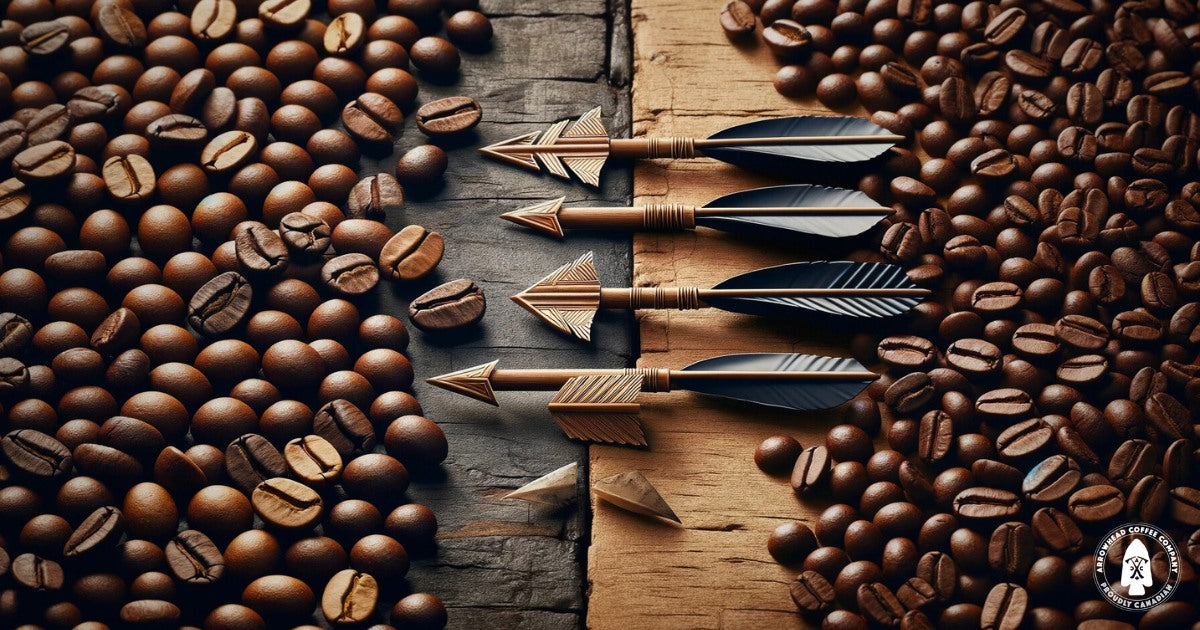My shopping cart
Your cart is currently empty.
Continue ShoppingWelcome to the delightful world of coffee roasts, where finding the perfect roast level—be it light, medium, or dark—can significantly enhance your morning cup of Joe. This article will dive into the exciting and complex world of light vs medium vs dark roast, decoding their unique flavors and profiles.

Whether you prefer a bright and vibrant cup or a rich and robust brew, understanding the characteristics of each roast can help you navigate the vast array of options available. Light roasts, known for their subtle acidity and floral notes, offer a delicate and nuanced flavor profile. On the other end of the spectrum, dark roasts boast deep, smoky flavors with less acidity, making them ideal for those who enjoy a bolder taste.
But what about medium roasts? This versatile roast balances the light and dark varieties, offering a satisfying combination of flavors. With caramel undertones and a touch of acidity, medium roasts are often the go-to choice for many coffee lovers.
So, grab your favorite mug, and join us as we explore the world of coffee roasts, uncovering the secrets of light, medium, and dark roasts and helping you find the perfect brew to start your day.
According to a 2022 study, drinking 1.5-3.5 cups of coffee per day can reduce the risk of death from cardiovascular disease, cancer, & all-cause mortality by 16-21% in comparison to non-coffee users.
Every coffee bean starts its journey with inherent qualities determined by its species, soil, climate, and altitude. Roasting transforms these raw beans into the complex and aromatic coffees we love. The Maillard reaction, a chemical reaction between amino acids and reducing sugars that gives browned foods their desirable flavor, plays a crucial role here. This reaction, alongside caramelization, varies significantly across different roasts, impacting flavor, body, and acidity. Light roasts retain more of the bean's original character, highlighting the terroir's influence, whereas dark roasts develop richer, more intense flavors, often with a hint of bitterness or smokiness.
Light roast coffee, often referred to as "blonde" or "cinnamon" roast, is the lightest of the three roast levels. It is characterized by its light brown color and minimal oil on the surface of the beans. Light roast coffee is roasted for a shorter period, allowing the natural flavors of the beans to shine through.
One of the defining characteristics of light roast coffee is its subtle acidity. This acidity gives the coffee a bright and vibrant taste, similar to that of citrus or berries. The acidity also contributes to the coffee's overall complexity, adding layers of flavor that can be enjoyed by those with a discerning palate.
In terms of flavor profile, light roast coffee is known for its delicate and nuanced flavors. It often exhibits floral notes, with hints of jasmine, lavender, or even tea-like flavors. The light roast brings out the natural sweetness of the beans, resulting in a cup of coffee that is smooth and well-balanced.
Medium roast coffee balances the light and dark varieties, offering a satisfying combination of flavors. This roast level is sometimes referred to as "city" or "American" roast and is characterized by its medium brown color and slightly stronger flavor profile compared to light roasts.
When it comes to taste and aroma, medium roast coffee offers a pleasant combination of flavors. It has a milder acidity compared to light roasts, making it more approachable for those who prefer a smoother cup of coffee. Medium roasts often have caramel undertones, with a touch of acidity that adds brightness to the overall flavor.
The medium roast process allows the coffee beans to develop a fuller body and a more robust flavor compared to light roasts. It retains some of the natural sweetness of the beans while also introducing hints of chocolate or nutty notes. This makes it a versatile choice that can be enjoyed black or with milk and sugar, depending on personal preference.
For those who enjoy a bolder taste, dark roast coffee is the way to go. Dark roast coffee, also known as "French" or "Italian" roast, is characterized by its dark brown color and shiny, oily surface. It undergoes a longer roasting process, resulting in beans with a rich and robust flavor profile.
The key characteristic of dark roast coffee is its low acidity. The longer roasting time reduces the acidity levels, resulting in a smoother and less acidic cup of coffee. This makes dark roasts more suitable for those with sensitive stomachs or those who prefer a less tangy taste.
In terms of flavor, dark roast coffee offers an intense experience. It often exhibits smoky or even charred flavors, with hints of bitterness. The longer roasting process caramelizes the sugars in the beans, creating a rich, chocolatey taste. Dark roasts also have a fuller body, with a velvety mouthfeel that lingers on the palate.

A common question among coffee enthusiasts and consumers alike is about the relationship between the roast level of coffee and its caffeine content. Contrary to popular belief, the difference in caffeine content between light, medium, and dark roasts is minimal and often not as significant as many think. The caffeine content in coffee beans is relatively stable during the roasting process, and any variations are more dependent on the bean type (Arabica vs. Robusta) and the amount of coffee used in brewing rather than the roast level itself.
Globally, coffee preferences vary widely, often influenced by historical, cultural, and economic factors. For instance, Italian espresso culture venerates dark roasts, valuing their strength and richness, perfectly suited to the espresso method. Scandinavian countries, known for their high coffee consumption, tend to prefer lighter roasts, appreciating the nuanced flavors and higher acidity that reflect their culinary sensibilities. These cultural preferences underscore the diversity of coffee appreciation, reminding us that coffee is a global language with many dialects.
Now that you understand the characteristics and flavor profiles of light, medium, and dark roasts, you might be wondering how to choose the perfect roast for your taste preferences. The answer lies in experimenting and exploring different options.
If you enjoy a bright and vibrant cup of coffee with subtle acidity and floral notes, light roast coffee is the way to go. It offers a delicate and nuanced flavor profile that can be enjoyed black or with a splash of milk.
On the other hand, if you prefer a well-balanced cup with a touch of acidity and caramel undertones, medium roast coffee is your best bet. It balances the light and dark varieties, offering a satisfying combination of flavors that can be enjoyed in various brewing methods.
For those who crave a bold and intense flavor experience with low acidity, dark roast coffee is the perfect choice. Its deep, smoky flavors and rich, chocolatey undertones are sure to satisfy even the most discerning coffee connoisseurs.
To truly appreciate the flavors of each roast level, it's important to use the right brewing techniques. Here are a few recommendations for brewing light, medium, and dark roast coffee:
Remember to adjust the grind size and brewing time according to the roast level to achieve the best results. Experiment with different brewing techniques and find the method that brings out the flavors you enjoy the most.
In conclusion, understanding the differences between light, medium, and dark roast coffee can open up a world of flavors and experiences, perfectly encapsulating the essence of light vs medium vs dark roast. Whether you prefer a bright and vibrant cup, a well-balanced brew, or a bold and intense flavor profile, there is a roast level that caters to your taste preferences.
Light roast coffee delivers delicate and nuanced flavors, characterized by subtle acidity and floral notes, embodying the lighter end of the spectrum. Medium roast coffee, finding its place in the middle, strikes a harmonious balance between light and dark, offering a satisfying combination of flavors with delightful caramel undertones. Dark roast coffee, on the opposite end, boasts bold and intense flavors, with low acidity and a rich, chocolatey taste, showcasing the depth and intensity that darker roasts bring.
By delving into the world of light, medium, and dark roasts, you can broaden your coffee palate and uncover new flavors that add joy to your morning routine. So, grab your favorite mug, brew a cup of your preferred roast, and savor the delightful experience that each roast level offers. Cheers to discovering the perfect roast in the journey of light vs medium vs dark roast!